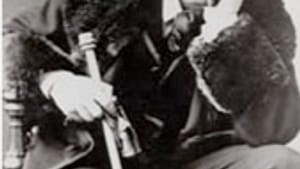Stay in the Loop
BSR publishes on a weekly schedule, with an email newsletter every Wednesday and Thursday morning. There’s no paywall, and subscribing is always free.
Center City Opera's "Dorian Gray' (2nd review)

Mr. Gray views his portrait
TOM PURDOM
Opera divides into two categories. In the classic form— the one most of us think of when hear the word opera— the high points are arias, duets, choruses and other big musical moments.
Lowell Liebermann’s The Picture of Dorian Gray, like most modern operas, belongs to the second category. Here the characters engage in dialogue much as they would do it in a play, except that they sing at each other instead of speaking.
A 19th-Century opera composer would have inserted a drinking song into the tavern scene, or created a hymn to romance for the section in which Dorian Gray falls in love with an actress. Some of them would have included such bits if the hero had just strolled by a tavern or glanced at a theater ad that featured a leading lady. Liebermann avoids that kind of indulgence. His big numbers are not arias but soliloquies— musical speeches in which a character expresses a passion or a point of view.
Liebermann’s functional, straightforward vocal music serves just one purpose: It adds appropriate emotion to the words. But it does achieve that aim. Overall, The Picture of Dorian Gray effectively dramatizes one of the modern world’s great horror fables.
Known by everyone, read by few
Liebermann began with good material, of course. People who’ve never read Oscar Wilde’s book— or seen the 1945 movie— know the story of Dorian Gray and his picture, just as we’re all familiar with Don Quixote, Victor Frankenstein and Dr. Jekyll and Mr. Hyde.
The Picture of Dorian Gray is more than a century old but more relevant than ever, as life spans continue to lengthen and medical progress continues to reduce the effects of aging.
Liebermann’s opera premiered in 1996, and the recent Center City Opera Theater production was billed as the world premiere of the “chamber orchestra” version. I’ve never seen the original, but I never had any sense I was listening to a small orchestra. The orchestra accompaniment contains the opera’s most creative music, in fact. Liebermann’s instrumental music sets the scene and underscores emotions, and it’s interesting in itself. The script requires 11 different scene changes, and the orchestral music carried the action and the mood across interludes that could have become awkward interruptions.
One flaw in the libretto
The infamous picture was set on an easel with its back to the audience. The changes in Dorian’s image were projected on a large screen at the rear of the stage. The picture of his ultimate degeneracy seemed more melodramatic than horrifying to my taste, even though the script does call for details like the bloodstained hands.
The libretto suffers from one serious flaw dramatically. Dorian Gray’s moral dissolution mostly takes place off stage. He commits one murder on stage, and we see him shoot up with heroin, but that’s about it. We must take the poor chap’s depravity on faith.
Scene-stealer
Center City Opera’s music director and conductor, Andrew Kurtz, assembled a solid ensemble cast. The scene-stealer the night I attended was baritone Jason Switzer, who played Dorian Gray’s corrupter, Lord Henry. In addition to his musical abilities, Switzer conveyed an imposing stage presence that rendered him a convincing bad influence.
Tenor Jose Garza is shorter than Switzer, with a smooth youthful face, and he brought a suitable innocence to a role that’s essentially the story of a naive young man led astray by a conniving aristocrat and his own natural desire to remain handsome. This was the first time it had occurred to me that you need a new picture every time any version of this story is produced on stage or screen. The original portrait shown on the screen was a real picture of Garza, and the two later versions were believable alterations. Like others who have played this role, Garza got to see what he’d look like if he strays too far from the path of virtue— an excellent moral lesson, I’m certain, and one that will serve him well on days when he might be inclined to indulge himself more and practice less.
To read another review by Steve Cohen, click here.
TOM PURDOM
Opera divides into two categories. In the classic form— the one most of us think of when hear the word opera— the high points are arias, duets, choruses and other big musical moments.
Lowell Liebermann’s The Picture of Dorian Gray, like most modern operas, belongs to the second category. Here the characters engage in dialogue much as they would do it in a play, except that they sing at each other instead of speaking.
A 19th-Century opera composer would have inserted a drinking song into the tavern scene, or created a hymn to romance for the section in which Dorian Gray falls in love with an actress. Some of them would have included such bits if the hero had just strolled by a tavern or glanced at a theater ad that featured a leading lady. Liebermann avoids that kind of indulgence. His big numbers are not arias but soliloquies— musical speeches in which a character expresses a passion or a point of view.
Liebermann’s functional, straightforward vocal music serves just one purpose: It adds appropriate emotion to the words. But it does achieve that aim. Overall, The Picture of Dorian Gray effectively dramatizes one of the modern world’s great horror fables.
Known by everyone, read by few
Liebermann began with good material, of course. People who’ve never read Oscar Wilde’s book— or seen the 1945 movie— know the story of Dorian Gray and his picture, just as we’re all familiar with Don Quixote, Victor Frankenstein and Dr. Jekyll and Mr. Hyde.
The Picture of Dorian Gray is more than a century old but more relevant than ever, as life spans continue to lengthen and medical progress continues to reduce the effects of aging.
Liebermann’s opera premiered in 1996, and the recent Center City Opera Theater production was billed as the world premiere of the “chamber orchestra” version. I’ve never seen the original, but I never had any sense I was listening to a small orchestra. The orchestra accompaniment contains the opera’s most creative music, in fact. Liebermann’s instrumental music sets the scene and underscores emotions, and it’s interesting in itself. The script requires 11 different scene changes, and the orchestral music carried the action and the mood across interludes that could have become awkward interruptions.
One flaw in the libretto
The infamous picture was set on an easel with its back to the audience. The changes in Dorian’s image were projected on a large screen at the rear of the stage. The picture of his ultimate degeneracy seemed more melodramatic than horrifying to my taste, even though the script does call for details like the bloodstained hands.
The libretto suffers from one serious flaw dramatically. Dorian Gray’s moral dissolution mostly takes place off stage. He commits one murder on stage, and we see him shoot up with heroin, but that’s about it. We must take the poor chap’s depravity on faith.
Scene-stealer
Center City Opera’s music director and conductor, Andrew Kurtz, assembled a solid ensemble cast. The scene-stealer the night I attended was baritone Jason Switzer, who played Dorian Gray’s corrupter, Lord Henry. In addition to his musical abilities, Switzer conveyed an imposing stage presence that rendered him a convincing bad influence.
Tenor Jose Garza is shorter than Switzer, with a smooth youthful face, and he brought a suitable innocence to a role that’s essentially the story of a naive young man led astray by a conniving aristocrat and his own natural desire to remain handsome. This was the first time it had occurred to me that you need a new picture every time any version of this story is produced on stage or screen. The original portrait shown on the screen was a real picture of Garza, and the two later versions were believable alterations. Like others who have played this role, Garza got to see what he’d look like if he strays too far from the path of virtue— an excellent moral lesson, I’m certain, and one that will serve him well on days when he might be inclined to indulge himself more and practice less.
To read another review by Steve Cohen, click here.
Sign up for our newsletter
All of the week's new articles, all in one place. Sign up for the free weekly BSR newsletters, and don't miss a conversation.

 Tom Purdom
Tom Purdom